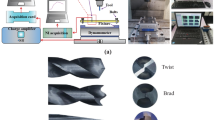Abstract
The aim of this study was to investigate the influence of drilling area temperature on the material properties and quality of machined carbon fiber reinforced polymer (CFRP) composites. For this purpose, an epoxy resin matrix CFRP composite was chosen and tested under carefully designed temperature-controlled drilling experiments using a climatic chamber. The results show that the optimal range of drilling area temperatures is lower than the lower limit of the glass transition zone temperature (T0) of the CFRP composite and higher than the upper limit for brittle deformation (T b ) of the resin. The reason for this is that when the drilling area temperature is higher than T0, the interfacial shear strength (IFSS) and anti-deformation capacity of the CFRP composite are poor, which leads to surface roughness and a large amount of exit delamination damage. For drilling area temperatures lower than T b , the CFRP becomes more brittle leading to a substantial increase in drilling thrust force, thereby increasing the probability of exit delamination damage. By solely maintaining the drilling area temperature between T0 and T b , the interlaminar fracture toughness, anti-deformation capacity, and IFSS of the composite can be increased, thereby decreasing the probability of drilling damage.
Similar content being viewed by others
References
Iliescu D, Gehin D, Iordanoff I, Girot F, Gutiérrez ME (2010) A discrete element method for the simulation of CFRP cutting. Compos Sci Technol 70(1):73–80
Shokrani A, Dhokia V, Newman ST (2012) Environmentally conscious machining of difficult-to-machine materials with regard to cutting fluids. Int J Mach Tool Manu 57(2):83–101
Tsao CC (2006) The effect of pilot hole on delamination when core drill drilling composite materials. Int J Mach Tool Manu 46(12–13):1653–1661
Tsao CC, Chiu YC (2011) Evaluation of drilling parameters on thrust force in drilling carbon fiber reinforced plastic (CFRP) composite laminates using compound core-special drills. Int J Mach Tool Manu 51(9):740–744
Tsao CC, Hocheng H (2008) Analysis of delamination in drilling composite materials by core-saw drill. Int J Mater Prod Technol 32(2–3):188–201
Mkaddem A, Soussia AB, Mansori ME (2013) Wear resistance of CVD and PVD multilayer coatings when dry cutting fiber reinforced polymers (FRP). Wear 302(1–2):946–954
Faraz A, Biermann D, Weinert K (2009) Cutting edge rounding: an innovative tool wear criterion in drilling CFRP composite laminates. Int J Mach Tool Manu 49(15):1185–1196
Karpat Y, Değer B, Bahtiyar O (2014) Experimental evaluation of polycrystalline diamond tool geometries while drilling carbon fiber-reinforced plastics. Int J Adv Manuf Technol 71(5–8):1295–1307
Phadnis VA, Makhdum F, Roy A, Silberschmidt VV (2013) Drilling in carbon/epoxy composites: experimental investigations and finite element implementation. Compos A: Appl Sci Manuf 47(1):41–51
Rao GVG, Mahajan P, Bhatnagar N (2007) Micro-mechanical modeling of machining of FRP composites—cutting force analysis. Compos Sci Technol 67(3–4):579–593
Weinert K, Kempmann C (2004) Cutting temperatures and their effects on the machining behaviour in drilling reinforced plastic composites. Adv Eng Mater 6(8):684–689
Yashiro T, Ogawa T, Sasahara H (2013) Temperature measurement of cutting tool and machined surface layer in milling of CFRP. Int J Mach Tool Manu 70(4):63–69
Santiuste C, Diaz-Alvarez J, Soldani X, Miguelez H (2013) Modelling thermal effects in machining of carbon fiber reinforced polymer composites. J Reinf Plast Compos 33(8):758–766
Bhattacharyya D, Horrigan DPW (1998) A study of hole drilling in Kevlar composites. Compos Sci Technol 58(2):267–283
Xia T, Kaynak Y, Arvin C, Jawahir IS (2016) Cryogenic cooling-induced process performance and surface integrity in drilling CFRP composite material. Int J Adv Manuf Technol 82(1):605–616
Jia Z, Fu R, Wang F, Qian B, He C (2016) Temperature effects in end milling carbon fiber reinforced polymer composites. Polym Compos 39:437–447
Miller B, Muri P, Rebenfeld L (1987) A microbond method for determination of the shear strength of a fiber/resin interface. Compos Sci Technol 28(1):17–32
Pitkethly MJ, Favre JP, Gaur U, Jakubowski J, Mudrich SF, Caldwell DL, Drzal LT, Nardin M, Wagner HD, di Landro L, Hampe A, Armistead JP, Desaeger M, Verpoest I (1993) A round-robin programme on interfacial test methods. Compos Sci Technol 48(1–4):205–214
Yang L, Thomason JL (2010) Interface strength in glass fibre–polypropylene measured using the fibre pull-out and microbond methods. Compos A: Appl Sci Manuf 41(9):1077–1083
Liu C, Wang G, Ren C, Yang Y (2014) Mechanistic modeling of oblique cutting considering fracture toughness and thermo-mechanical properties. Int J Adv Manuf Technol 74(9–12):1459–1468
O’Brien TK, Martin RH (1993) Round Robin testing for mode I interlaminar fracture toughness of composite materials. J Compos Technol Res 15(4):269–281
Gururaja S, Ramulu M (2009) Modified exit-ply delamination model for drilling FRPs. J Compos Mater 43(5):483–500
Haddad M, Zitoune R, Eyma F, Castanie B (2014) Study of the surface defects and dust generated during trimming of CFRP: influence of tool geometry, machining parameters and cutting speed range. Compos A: Appl Sci Manuf 66(6):142–154
Haddad M, Zitoune R, Eyma F, Castanié B (2015) Influence of machining process and machining induced surface roughness on mechanical properties of continuous fiber composites. Exp Mech 55(3):519–528
Saleem M, Toubal L, Zitoune R, Bougherara H (2013) Investigating the effect of machining processes on the mechanical behavior of composite plates with circular holes. Compos A: Appl Sci Manuf 55(6):169–177
Funding
The authors gratefully acknowledge financial support from the Fundamental Research Funds for the Central Universities (grant no. xjj201760).
Author information
Authors and Affiliations
Corresponding author
Rights and permissions
About this article
Cite this article
Wang, H., Zhang, X. & Duan, Y. Effects of drilling area temperature on drilling of carbon fiber reinforced polymer composites due to temperature-dependent properties. Int J Adv Manuf Technol 96, 2943–2951 (2018). https://doi.org/10.1007/s00170-018-1810-7
Received:
Accepted:
Published:
Issue Date:
DOI: https://doi.org/10.1007/s00170-018-1810-7




